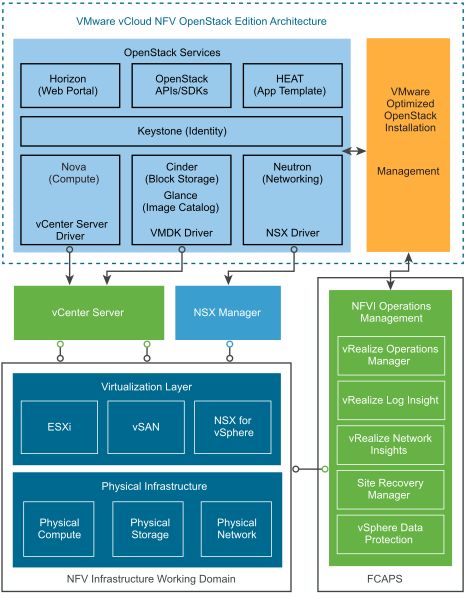Modularity is one of the key design principles and with this reference architecture release, integrating VMware Integrated OpenStack into the platform follows that direction. VMware Integrated OpenStack greatly simplifies the deployment of an OpenStack cloud infrastructure by streamlining the integration process. VMware Integrated OpenStack is a VMware distribution that starts its life with upstream OpenStack code and is then hardened, tested and preconfigured to use VMware-optimized OpenStack drivers. VMware Integrated OpenStack includes tools required to install, upgrade, and operate a production-grade OpenStack cloud on top of VMware technologies.
OpenStack is a cloud operating system that manages pools of storage, network, and compute resources through a dashboard while allowing users to provision resources through a Web interface. Each of these resources are managed by core OpenStack services that are developed by corresponding OpenStack projects. Figure 4 provides a high-level overview of the resource abstrtaction layers and infrastructure services for the VNFs

VMware Integrated OpenStack packages core OpenStack components such as Nova, Neutron, Cinder, Glance, Keystone, Heat, and Horizon. Administrators and tenants can use the OpenStack user interface (Horizon) or APIs to consume and deploy and manage resources in the OpenStack cloud. These VMware Integrated OpenStack services are run in one or more virtual machine instances managed by the OpenStack management server.

The following is a list of OpenStack components and services:
- Nova. This component sees each VMware vSphere compute cluster as a single compute node and selects the vSphere cluster in which to place the VNF workloads. Once a cluster is selected, vCenter uses the VMware vSphere Distributed Resource Scheduler (DRS) to optimally place the VNF within the cluster. DRS also balances workloads for optimal performance during runtime.
- Cinder. This component executes block volume operations through a VMDK driver. VMware vCenter creates the volume, which initially belongs to a shadow VM. When the volume is attached to a running VM, vCenter changes the parent for the volume from the shadow VM to the actual VM.
- Glance. This component manages images stored in a set of dedicated image service storage containers. VMware Integrated OpenStack supports ISO, VMDK or OVA formats, but RAW, QCOW2, VDI or VHD formats can also be imported using the CLI.
- Neutron. This component is used to provide the networking services for the creation of virtual network resources that are used for tenants. It communicates with the NSX Manager to manage virtual network resources in the OpenStack cloud. NSX Edge devices functions as an OpenStack Layer 3 agent, Metadata server, DHCP Layer 2 agent, tenant networking, and security group policy enforcement.
- Horizon. This component provides the Web-based user interface for interacting with OpenStack APIs to perform common cloud operations. This interface is available to both cloud administrators and users.
- Keystone. This component is used in OpenStack as an identity source for user authentication, authentication token management, and as a central service catalog for finding the API endpoints of OpenStack services.
- Heat. Heat is the orchestration service used for launching instances connected together.
The VMware Integrated OpenStack Manager vApp in vCenter deploys and manages an instance of VMware Integrated OpenStack. The Integrated OpenStack Manager provides a workflow that allows CSPs to deploy VMware Integrated OpenStack in a few clicks, from within the vSphere Web Client.